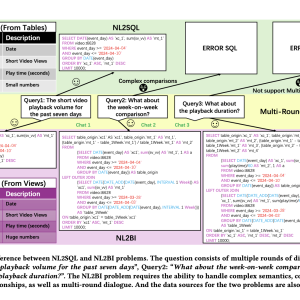

The rapid advancement of Large Language Models (LLMs) has sparked interest among researchers in academia and industry alike. Both the Natural Language Processing (NLP) and database communities are exploring the potential of LLMs in tackling the Natural Language to SQL NL2SQL task, which involves converting natural language queries into executable SQL statements consistent with user intent.
As thousands of organizations leverage Business Intelligence (BI) for decision support, industry researchers have honed in on NL2BI, a scenario where natural language is transformed into BI queries. NL2BI enables non-expert users, such as product managers or operations personnel, to conduct data analysis, facilitating decision-making processes
In the Natural Language to Business Intelligence NL2BI scenario, human interaction plays a pivotal role, often involving Multi-Round Dialogue (MRD) scenarios where users engage in iterative conversations to refine queries. Existing NL2SQL methods primarily handle Single-Round Dialogue (SRD) queries and struggle with MRD scenarios. Consequently, transitioning to complex BI queries, such as Week-on-Week comparisons, presents challenges for existing NL2SQL approaches. Moreover, differences in data table structures between BI and traditional SQL contexts further complicate the translation process.
Researchers have primarily focused on enhancing NL2SQL methods, which can be categorized into pre-trained and Supervised Fine-Tuning (SFT) methods, prompt engineering-based LLMs, and LLMs specifically trained for NL2SQL. However, when applied to real-world BI scenarios, these methods encounter limitations, particularly in effectively addressing MRD interactions. Challenges persist in accurately discerning between SRD and MRD queries and adapting prompt engineering techniques to accommodate MRD scenarios.
The researchers propose novel solutions tailored to the NL2BI scenario to address these challenges. They introduce methodologies to handle MRD interactions effectively and transform schema linking into a single view selection problem, leveraging database view technology. Additionally, they advocate for a phased process flow in query generation, emphasizing structured intermediate results to handle complex semantics and comparison relationships more effectively.
The proposed approach, dubbed ChatBI, is deployed in production environments and integrated into multiple product lines. Comparative evaluations against mainstream NL2SQL methods demonstrate ChatBI’s superiority in terms of accuracy and efficiency. By addressing the unique challenges of NL2BI scenarios and leveraging structured intermediate results, ChatBI represents a significant advancement in natural language-based BI query generation, facilitating enhanced decision-making processes for non-expert users.
Check out the Paper. All credit for this research goes to the researchers of this project. Also, don’t forget to follow us on Twitter. Join our Telegram Channel, Discord Channel, and LinkedIn Group.
If you like our work, you will love our newsletter..
Don’t Forget to join our 42k+ ML SubReddit
The post ChatBI: A Comprehensive and Efficient Technology for Solving the Natural Language to Business Intelligence NL2BI Task appeared first on MarkTechPost.